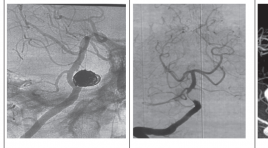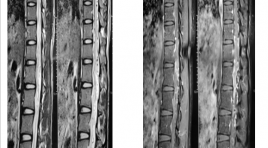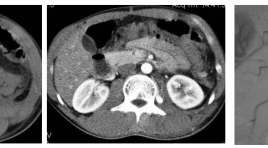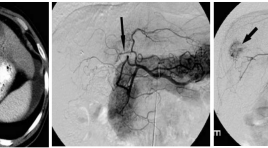
Kết quả điều trị phình động mạch não tuần hoàn sau bằng can thiệp nội mạch
01/04/2020 13:24:26 | 0 binh luận
Results of endovascular treatment of posterior fossa intracranial aneuryms SUMMARY Purpose : To evaluate the results of endovascular treatment of posterior fossa intracanial aneuryms. Method and materials: Fourty one patients harboring fourty five posterior fossa intracranial aneuryms were treated by endovascular therapy from 2012 to 2015 at Bach Mai Hospital. Clinical outcomes and follow-up of aneurysm occlusion’s result were classified by modified Rankin Scale and on MRI imaging. Results: Twenty eight patients presented subaranoidien hemorrhage and thirteen patients without SAH. Different technics were used such as coiling embolization (44.4%), coiling with balloon remodeling technics (22.2%), coiling with stenting (2.3%), flow-diverter stenting (6.7%) and parent artery occlusion (24.4%). The rate of complete aneurysm occlusion, neck residue and partial occlusion were 80%; 11.1% and 8.9% respectively. Result of good outcomes (mRS 0-2) was 85.4% and mortality was 12.2%. Almost of aneurysms post treatment were stability (84.6%), only 15,4% aneurysm were slight recanalization. The hospitalization duration of unruptured and ruptured aneurysm were 9.3 and 17.8 days, respectively. Conclusion: Endovascular treatment of posterior circulation aneurysms showed efficace of clinical outcome and stability with low morbility and mortality. Keywords: Aneurysm, posterior circulation aneurysm, embolization.

Điều trị dị dạng động tĩnh mạch thận bẩm sinh bằng can thiệp nội mạch
01/04/2020 13:39:14 | 0 binh luận
Transarterial embolization in management of congenital renal arteriovenous malformation SUMMARY Objective: To evaluate the safety and efficacy of transarterial embolization (TAE) in management of congential renal arteriovenous malformation (AVM). Patients and Methods: Between December 2007 and June 2015, 11 patients with congential renal AVM treated with TAE was investigated for clinical presentation, imagine features, treatment methods and complications in Viet Duc hospital. Results: 11 patients (9 women/2 men) with 10/11 gross hematuria, 5/11 flank pain and 1/11 hypertension underwent 11 sessions of treatment, TAE was performed with histoacryl + lipiodol in 7 patients, micro-coils in 3 patients, absolute alcohol and histoacryl in 1 patient. Technical and clinical success were obtained in all patients. There was only 1 patient with fever, renal function was normal in all patient pre - embolization and post - embolization. Conclusion: TAE treatment was safe and effective, it should be recommended as the first choice to treat congential renal AVM. Key word : renal arteriovenous malformation, embolization.

Đánh giá hiệu quả ban đầu của can thiệp mạch trong điều trị dị dạng mạch máu tủy
31/03/2020 19:20:03 | 0 binh luận
The preliminary result of endovascular treatment in spinal vascular malformation SUMMARY Objective : To evaluate the preliminary result of endovascular treatment in spinal vascular malformation. Material and method: We prospectively studied patients with spinal arteriovenous shunt who were diagnosed and endovascular treatement with spinal arteriovenous shunt at Bach Mai hospital from 2012 to 2013. Clinical features were analyzed before and after treatment by Aminoff-Logue disability scale. MR imaging characteristics were evaluated. Result: 9 patients were treated by endovascular embolization, 44.4% were spinal arteriovenous malformation, 55.6% were spinal dural arteriovenous fistulae. MRI studies showed intramedullary increased T2 signal and dilated venous drainage in all patients. The rate of complete angiographic obliteration was 55.5% and nearly occluded in 45.5 . After follow up of 3 months, clinically significance improvement was achieved in 66.7%, partial recovery in 22.2%. Conclusion: n-BCA glue embolization for spinal arteriovenous shunt should be considered the treatment of choice with satisfactory outcomes. Large studies with longer follow-up are required to determinate the safety and efficacy of endovascular treatment.

Gía trị của phương pháp tiêm diệt hạch đám rối tạng bằng cồn tuyệt đối dưới cắt lớp vi tính
31/03/2020 13:00:47 | 0 binh luận
Evaluation the celiac plexus neurolysis with absolute alcohol injected percutaneously under CT guidance summa ry Objective: By 3 cases of celiac plexus neurolysis with absolute alcohol injected percutaneously under the CT guidance this article is aimed to discuss about the technic, indications and also to evaluate the short-term efficacy of this procedure,. Results : The pain relief was always obtained during the procedure without any grave complication. This old technique performed for the first time in our institution with a good short-term result made a new hope for patient with intense abdominal pain due to cancer or chronic pancreatitis. Conclusion : This technique was found to be safe and effective in treating the abdominal pain due to cancer or chronic pancreatitis. Key words: celiac plexus neurolysis, alcoholization, CT guidance, palliative care.

Ứng dụng phương pháp nút mạch can thiệp trong điều trị ung thư biểu mô tế bào gan nguyên phát
03/04/2020 12:46:00 | 0 binh luận
Application TACE in primary hepato-cellular carcinoma summa ry Objectiv and methode: Transcatheter Arterial Chemo- Embolization(TACE) for 23 patients suffered from HCC (Hepato- Cellular Carcinoma) with 34 times of embolization. Results : The tumoral diameter is decreased after 1, 3 months but no statically significant. The intra-tumoral hypervascularity is changing corresponding to the AFP level and the Lipiodol deposition. Some serum biochemical index such as GOT, GPT and Bilirubin are decresed but not statistically significant. Postembolization syndrome appeared in short time. Mean survival time is 15,25 ± 9,04 months. Life standard quality is improved. Conclusion : TACE is a palliativ treatment method however it can offer good result such as prolonging survival time and improving life standard quality.

Kĩ thuật và kết quả bước đầu điều trị ung thư gan bằng đốt sóng cao tần tạ khoa chẩn đoán hình ảnh - Bệnh viện Bạch Mai - Hà Nội
03/04/2020 11:15:46 | 0 binh luận
Technique and early outcome of RFA in treating HCC at the Radiology Department Bach Mai, Hanoi summa ry Hepatocellular carcinoma (HCC) management has become varied with different ways, which are applicable for different stages of the disease. Hepatic resection forms part of the conventional treatment for patients with the disease; however, the majority of primary liver cancers are not suitable for curative treatment at the time of diagnosis. Local curative therapy is getting more and more used. Radiofrequency ablation (RFA) is the first line indication for inoperable patients. Objective : To describe techniques and early outcomes of RFA in treating HCC patients at Radiology Department, Bach Mai Hospital, Hanoi. Method: descritive, retrospective, from 4/2010 to 12/2012 on 43 patients; image-guided techniques were used to treat the patients and evaluate results. Findings : male/female=35/8, average age = 54.5 (36-76), commonest tumor size is 3-5 cm (80%), majority of the patients had Child A (95%) and infected with HBV (98%); ultrasound imaged and cluster needles were performed on 77% and 80% respectively; post-intervention status was stable and without complication on 100% of the patients; 1-year and 2-year suvival rates were 95% and 88% correspondingly, of whom local recurrence appeared in two cases after five months and one case after one year. Conclusion : RFA in HCC management is safe and effective at the Radiology Department at Bach Mai Hospital, even in complicated cases.

Điều trị giả phình động mạch thắt lưng sau chấn thương bằng phương pháp can thiệp nội mạch
03/04/2020 10:41:20 | 0 binh luận
Post-traumatic lumbar pseudo-aneurysm treatment by endovascular intervention SUMMARY Pseudo-aneurysm of the lumbar artery is a rare lesion at the abdominal injury though these arteries have small dimension and retro peritoneal localization. Ruprture of the aneurysm can infl uence to the patient life. Diagnostic imaging and deciding to early treatment play an important role.We present a case of the affection being treated sucessfully by endoluminal intervention.

Đánh giá hệ thống tuần hoàn bàng hệ ngoài gan trong điều trị ung thư biểu mô tế bào gan bằng nút hóa chất động mạch qua catheter
03/04/2020 10:37:53 | 0 binh luận
Evaluation of extrahepatic colateral vessel supply in treatment of HCC by TACE SUMMARY Hepatocellular carcinoma (HCC) is a leading cause of morbidity and mortality, ranking fi fth for men and eighth for women as a source of primary malignancy. The highest incidences of HCC are found in sub-Saharan Africa and Eastern Asia, Southeastern Asia with incidence rates of 17.43 and 6.77 per 100,000 in men and women of developing countries compared with 8.71 and 2.86 per 100,000 in men and women of developed regions of the world [2],[6]. The three curative options of resection, liver transplantation, and percutaneous ablation compete as fi rst-line treatment modalities for early HCC, achieving 5-year survival rates of 50-70% [18]. At these advanced stages of HCC, arterial embolization techniques combined with intra-arterial chemotherapy has been shown to be an effective palliative therapy that can also improve patient survival [19],[20]. HCC chemoembolization is based on the fact that the normal liver parenchyma receives a dual blood supply from the hepatic artery and the portal vein, whereas HCCs are supplied exclusively by the hepatic artery. In practice, many HCCs are supplied by extrahepatic collateral arteries even when the hepatic artery is patent [13],[19]. Detect these extraheparic colateral vessel supply as well as ways in which to improve the effective and avoid complications of TACE of the collateral vessels.
Bạn Đọc Quan tâm
Sự kiện sắp diễn ra
Thông tin đào tạo
- Những cạm bẫy trong CĐHA vú và vai trò của trí tuệ nhân tạo
- Hội thảo trực tuyến "Cắt lớp vi tính đếm Photon: từ lý thuyết tới thực tiễn lâm sàng”
- CHƯƠNG TRÌNH ĐÀO TẠO LIÊN TỤC VỀ HÌNH ẢNH HỌC THẦN KINH: BÀI 3: U não trong trục
- Danh sách học viên đạt chứng chỉ CME khóa học "Cập nhật RSNA 2021: Công nghệ mới trong Kỷ nguyên mới"
- Danh sách học viên đạt chứng chỉ CME khóa học "Đánh giá chức năng thất phải trên siêu âm đánh dấu mô cơ tim"












